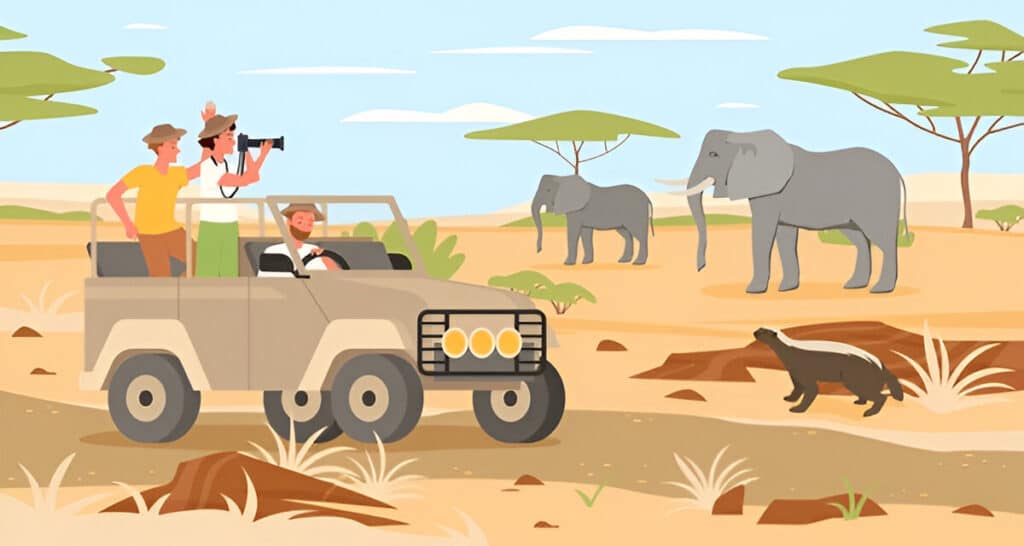Africa is the second largest continent (30 million km2) with 26,000 km of coastline. It is also the second most populated continent with approximately one billion inhabitants unevenly distributed over 54 sovereign states.
Africa has been viewed as an exotic, distant, and challenging destination based on early colonial and missionary forays into the “dark continent.” Besides exoticism, the continent’s main appeals are its great diversity of natural landscapes and cultural richness.
One of the principal tourism products is the safari—“to travel” in Kiswahili, and that in its nineteenth century roots meant a hunt for animals in the wild.
History of Tourism in Africa

Tourism development in the continent emerged in tandem with the nineteenth-century colonialism. Egypt, Morocco, Tunisia, Kenya, South Africa, Swaziland, and Zambia all experienced early development, mostly based on the desires of European and North American tourists.
Africa’s imagery was connected to imperial explorations and expansion, the construction of “the native,” and in the Maghreb with notions of orientalism. Up to the 1950s, tourism growth was dependent on the limited ownership of automobiles by the white “European” elite, with unreliable road networks being nonetheless promoted by automobile clubs established in the early twentieth century.
From the 1930s, with the development of aviation networks from colonial centers of power in Europe, air transport became an important channel for tourism growth.
However even today, air transport is perceived as a major constraint to Africa’s tourism development. High airfares and inconvenient, unsafe, and insufficient service of scheduled and charter services are common problems in many
countries.
Growth and Development

After Morocco’s and Tunisia’s independence in the 1950s and later of Kenya and Tanzania, tourism was viewed as a “passport to development,” and nature tourism assumed an important role.
During the 1990s, South African tourism grew considerably (94 % between 1990 and 2002) and continued into the twenty-first century with megaevents and growth in convention-oriented business tourism.
Today, safari remains a centerpiece of tourism products in Botswana, Kenya, South
Africa, Tanzania, and Zambia, and trans-frontier wildlife tourism is expected to be a successful formula.
On the other hand, island tourism has also registered sustained above average growth in countries like Cape Verde (27 %), Reunion (12 %), and Seychelles (11 %). In 2009, 31 % of international tourists were Europeans, 43 % were Africans, and only 4% were from the Americas (UNWTO 2011).
The main entry points are located in South Africa, the resorts of Egypt and Tunisia, Casablanca, Addis Ababa, Nairobi, and Lagos. Road and rail networks at continental scale are inadequate, as they are at a national and regional scale in many countries.
Port facilities are insufficient. While major international events such as the FIFA
World Cup soccer tournament have spurred development in South Africa, other African countries have experienced far lesser tourism infrastructure investment.
Tourism is highly concentrated on a few destinations: South Africa (29 %) and Morocco (22 %) contribute about half of the total number of international arrivals. In 2012, the region enjoyed 52.4 million tourists (almost doubled since 2000), and the latest UNWTO forecasts that arrivals will increase from 85 million in 2020 to 134 million in One out of every 11 jobs comes from the tourism industry.
Despite the positive development of the past years, Africa accounts for only 5% of global tourism and for 3% of receipts, which amounted to US$ 1 billion (this figure was more than trebled since 2000). In 2012 the total contribution to GDP increased to 9% and to 7.1% of total employment (WTTC 2013).
Tourism in North Africa, one of the most important regions in the continent (33% of all international arrivals), has suffered a sizeable decline since the Arab Spring of 2011. Tunisia has been the most affected country in the region, with a loss of 31% of international tourists from 2010 to 2011.
Several international and regional bodies such as UNWTO Commission for Africa, African Tourism Organization (sub-Saharan African nonprofit organization formed in 2004), RETOSA (Regional Tourism Organization of Southern Africa), and NEPAD (New Partnership for Africa’s Development) are concerned with tourism in the continent.
Policies and strategies are mostly developed at a national level and tend to mirror neoliberal development agendas that underline the role of the private sector and global competitiveness. These policies need to be further articulated with the sectorial policies, namely, education, nature conservation, health, and information and communication technologies.